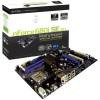EVGA 122-CK-NF63-TR User Manual - Page 79
Jumper Settings
 |
View all EVGA 122-CK-NF63-TR manuals
Add to My Manuals
Save this manual to your list of manuals |
Page 79 highlights
Installing and Configuring the EVGA nForce 680i SLI Motherboard PCI Express x1 Slot There is two PCI Express x1 slots that are designed to accommodate less bandwidth-intensive cards, such as a modem or LAN card. The x1 slot provides 250 MB/sec bandwidth. PCI Express x16 Slots These two PCI Express x16 slots are reserved for graphics or video cards. The bandwidth of the x16 slot is up to 4GB/sec (8GB/sec concurrent). The design of this motherboard supports dual PCI-Express graphics cards using NVIDIA's SLI technology with multiple displays. When installing a PCI Express x16 card, be sure the retention clip snaps and locks the card into place. If the card is not seated properly, it could cause a short across the pins. Secure the card's metal bracket to the chassis back panel with the screw used to hold the blank cover. Jumper Settings The motherboard contains a 3-pin BIOS configuration jumper that enables all board configurations to be done in the BIOS Setup program. The silk screen on the motherboard shows a ∆ next to pin 1. Clear CMOS Jumper: CLR_CMOS The motherboard uses the CMOS RAM to store all the set parameters. The CMOS can be cleared by removing the CMOS jumper. Use the following procedure to clear CMOS: 1. Turn off the AC power supply and connect pins 1 and 2 together using the jumper cap. 2. Return the jumper setting to normal (pins 2 and 3. Together with the jumper cap). 4. Turn the AC power supply back on. 28















